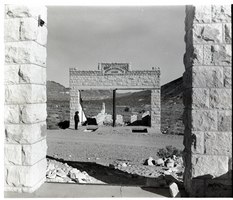Search the Special Collections and Archives Portal
Search Results
Brenda Arnold oral history interview
Identifier
Abstract
Oral history interview with Brenda Arnold conducted by Janet E. Prince on February 28, 1977 for the Ralph Roske Oral History Project on Early Las Vegas. Arnold discusses her career as a librarian, her religious activities in Las Vegas, Nevada, and viewing the above-ground atomic testing. She also recounts activities she did while visiting Lake Mead and Harris Springs at Mount Charleston.
Archival Collection
Ken Stichter oral history interview
Identifier
Abstract
Oral history interview with Dr. Ken Stichter conducted by Kate Ward on March 08, 2003 for the Public School Principalship Oral History Project. In this interview, Dr. Stichter reflects upon his career as a teacher and administrator in Southern California. He describes his motivations for becoming a principal, his regular responsibilities and challenges, and his working relationships with teachers, students, and other administrators. He also discusses his experience as an assistant superintendent, and compares it with his experience as a principal.
Archival Collection
Andre King oral history interview
Identifier
Abstract
Oral history interview with Andre "Brother Dre" King conducted by Claytee D. White on July 20, 2018 for the Remembering 1 October Oral History Project. In this interview, King recalls learning judo and wrestling at an early age. After spending ten years in prison for a burglary offense, he served an additional eleven years in facilities across the state. After twenty-one years in the system, King is now a nondenominational spiritual being and once he learned about the Healing Garden for 1 October victims, he went there daily, during and immediately after the construction. King has helped many survivors and has healed himself as well, through giving love, hugs, and spiritual inspiration.
Archival Collection
Marie Wakefield oral history interview
Identifier
Abstract
Oral history interview with Marie Wakefield conducted by Ashley Hardison on November 30, 2008 for the Public School Principalship Oral History Project. In this interview, Wakefield reflects upon her career as an administrator with Nevada’s Clark County School District. She describes her experience as principal of Myrtle Tate Elementary School, her regular job responsibilities, and challenges that she faced. She also describes her experience as an African American woman, and the importance of student and faculty diversity within schools.
Archival Collection
Bill Beam Papers
Identifier
Abstract
The Bill Beam Papers document the career of miner and poetry enthusiast Bill (William) Beam from 1955 to 2004. The papers contain mining materials, photographs, and poetry from mines Beam worked in around the Southwestern United States. Also included are two albums of photographs from the Nevada Test Site.
Archival Collection
Nellis Air Force Base Installation Restoration Program Records
Identifier
Abstract
The collection, dated 1988-1999, was created by the United States Air Force, Nellis Air Force Base, Nevada. It consists of unclassified documents relating to the implementation of the Installation Restoration Program (IRP) of environmental remediation and restoration for Department of Defense (DOD) military installations, ranges, and disposal sites in Nevada.
Archival Collection
Karen Sarret Bartolo oral history interview
Identifier
Abstract
Oral history interview with Karen Sarret Bartolo conducted by Judy Harrell on November 25, 2013 for the West Charleston Neighborhoods--an Oral History Project of Ward 1. Bartolo recalls how it was growing up in Las Vegas, Nevada and her involvement with the Mormon Church. Bartolo then talks about her father's business, her starting a family and teaching for Clark County School District until retiring.
Archival Collection
Gladys Boggs Marshall Papers
Identifier
Abstract
The Gladys Boggs Marshall Papers consist of various artistic works created by Gladys Boggs Marshall, written from 1907 to 1974. The papers include several of her poems, a manuscript draft of an unfinished paper "History and Story of Las Vegas," a scrapbook of family photographs, sheet music, and newspaper clippings.
Archival Collection
Mavis Eggle "Books as They Were Bought" Collection
Identifier
Abstract
The Mavis Eggle "Books as They Were Bought" collection provides a broad overview of printed material from the 1780s through 1949. Gathered by book collector Mavis Eggle, the collection serves as a social history of books, newspapers, and ephemera. Physical characteristics of the books include a variety of printer's marks, publishers' bindings, bookplates, and early subscription libraries. The collection's titles are a diverse and creative gathering of poetry, children' literature, religious texts, broadsides, newspapers, and popular fiction. Together, the items in the Mavis Eggle "Books as They Were Bought" collection illustrate changes in literature, printing and publishing, advertising, and book history over a time period of more than 170 years.
Archival Collection

Film transparency of the ruins of the H. D. and L. D. Porter Brothers Store, Rhyolite, Nevada, November 25, 1948
Date
Archival Collection
Description
Image
